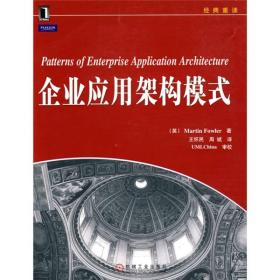
企业应用架构模式
¥ 19.98 2.5折 ¥ 79 九品
仅1件
北京昌平
认证卖家担保交易快速发货售后保障
作者[美]福勒 著
出版社人民邮电出版社
出版时间2009-06
版次1
装帧平装
货号A5
上书时间2024-12-23
- 在售商品 暂无
- 平均发货时间 15小时
- 好评率 暂无
- 最新上架
商品详情
- 品相描述:九品
图书标准信息
- 作者 [美]福勒 著
- 出版社 人民邮电出版社
- 出版时间 2009-06
- 版次 1
- ISBN 9787115204226
- 定价 79.00元
- 装帧 平装
- 开本 16开
- 纸张 胶版纸
- 页数 533页
- 字数 667千字
- 正文语种 英语
- 原版书名 Patterns of Enterprise Application Architecture
- 丛书 图灵程序设计丛书
- 【内容简介】
- 面向对象大师MartinFowler及其专家级合作者将40多种常用解决方案转化成模式,为我们提供了这本能够应用于任何一种企业应用平台的、关于解决方案的参考书。《企业应用架构模式(英文版)》叙述深入浅出,采用大量UML图进一步阐明有关概念。前面介绍企业应用的背景知识,如分层架构、Web表现、业务逻辑、数据库映射、并发、会话、分布策略等。在此基础上,随后的各章分别对与这些背景知识相关的设计模式进行了详细的介绍,并配以详细的Java代码或C#代码示例。《企业应用架构模式(英文版)》适合设计和构建企业应用的软件架构师、设计人员和编程人员阅读,同时也可作为高等院校计算机专业及软件学院相关课程的参考教材。
- 【作者简介】
- MartinFowler:享誉世界的软件开发大师。现为著名软件开发咨询公司ThoughtWorks的首席科学家。他在面向对象分析与设计、UML、设计模式、软件开发方法学、XP、重构等方面都有重要贡献。他更全球最具影响力的技术作家之一,除本书外,他的《分析模式》、《UML精粹》和《重构》等著作都已经成为经典。
- 【目录】
-
Prefacexvii
WhoThisBookIsForxx
Acknowledgmentsxxi
Colophonxxiii
Introduction1
Architecture1
EnterpriseApplications2
KindsofEnterpriseApplication5
ThinkingAboutPerformance6
Patterns9
TheStructureofthePatterns11
LimitationsofThesePatterns13
PART1:TheNarratives15
Chapter1:Layering17
TheEvolutionofLayersinEnterpriseApplications18
TheThreePrincipalLayers19
ChoosingWheretoRunYourLayers22
Chapter2:OrganizingDomainLogic25
MakingAChoice29
ServiceLayer30
Chapter3:MappingtoRelationalDatabases33
ArchitecturalPatterns33
TheBehavioralProblem38
ReadinginData40
StructuralMappingPatterns41
MappingRelationships41
Inheritance45
BuildingtheMapping47
DoubleMapping48
UsingMetadata49
DatabaseConnections50
SomeMiscellaneousPoints52
FurtherReading53
Chapter4:WebPresentation55
ViewPatterns58
InputControllerPatterns61
FurtherReading61
Chapter5:Concurrency(byMartinFowlerAndDavidRice)63
ConcurrencyProblems64
ExecutionContexts65
IsolationAndImmutability66
OptimisticAndPessimisticConcurrencyControl67
PreventingInconsistentReads68
Deadlocks70
Transactions71
ACID71
TransactionalResources72
ReducingTransactionIsolationforLiveness73
BusinessAndSystemTransactions74
PatternsforOfflineConcurrencyControl76
ApplicationServerConcurrency78
FurtherReading80
Chapter6:SessionState81
TheValueofStatelessness81
SessionState83
WaystoStoreSessionState84
Chapter7:DistributionStrategies87
TheAllureofDistributedObjects87
RemoteAndLocalInterfaces88
WhereYouHavetoDistribute90
WorkingwiththeDistributionBoundary91
InterfacesforDistribution92
Chapter8:PuttingItAllTogether95
StartingwiththeDomainLayer96
DowntotheDataSourceLayer97
DataSourceforTransactionScript(11O)97
DataSourceforTableModule(125)98
DataSourceforDomainModel(116)98
ThePresentationLayer99
SomeTechnology-SpecificAdvice100
JavaAndJ2EE100
NET101
StoredProcedures102
WebServices103
OtherLayeringSchemes103
PART2:ThePatterns107
Chapter9:DomainLogicPatterns109
TransactionScript110
HowItWorks110
WhentoUseIt111
TheRevenueRecognitionProblem112
Example:RevenueRecognition(Java)113
DomainModel116
HowItWorks116
WhentoUseIt119
FurtherReading119
Example:RevenueRecognition(Java)120
TableModule125
HowItWorks126
WhentoUseIt128
Example:RevenueRecognitionwithATableModule(C#)129
ServiceLayer(byRandyStafford)133
HowItWorks134
WhentoUseIt137
FurtherReading137
Example:RevenueRecognition(Java)138
Chapter10:DataSourceArchitecturalPatterns143
TableDataGateway144
HowItWorks144
WhentoUseIt145
FurtherReading146
Example:PersonGateway(C#)146
Example:UsingADONETDataSets(C#)148
RowDataGateway152
HowItWorks152
WhentoUseIt153
Example:APersonRecord(Java)155
Example:ADataHolderforADomainObject(Java)158
ActiveRecord160
HowItWorks160
WhentoUseIt161
Example:ASimplePerson(Java)162
DataMapper165
HowItWorks165
WhentoUseIt170
Example:ASimpleDatabaseMapper(Java)171
Example:SeparatingtheFinders(Java)176
Example:CreatingAnEmptyObject(Java)179
Chapter11:Object-RelationalBehavioralPatterns183
UnitofWork184
HowItWorks184
WhentoUseIt189
Example:UnitofWorkwithObjectRegistration(Java)
(byDavidRice)190
IdentityMap195
HowItWorks195
WhentoUseIt198
Example:MethodsforAnIdentityMap(Java)198
LazyLoad200
HowItWorks200
WhentoUseIt203
Example:LazyInitialization(Java)203
Example:VirtualProxy(Java)203
Example:UsingAValueHolder(Java)205
Example:UsingGhosts(C#)206
3hapter12:Object-RelationalStructuralPatterns215
IdentityField216
HowItWorks216
WhentoUseIt220
FurtherReading221
Example:IntegralKey(C#)221
Example:UsingAKeyTable(Java)222
Example:UsingACompoundKey(Java)224
ForeignKeyMapping236
HowItWorks236
WhentoUseIt239
Example:Single-ValuedReference(Java)240
Example:MultitableFind(Java)243
Example:CollectionofReferences(C#)244
AssociationTableMapping248
HowItWorks248
WhentoUseIt249
Example:EmployeesAndSkills(C#)250
Example:UsingDirectSQL(Java)253
Example:UsingASingleQueryforMultipleEmployees(Java)
(byMattFoemmelAndMartinFowler)256
DependentMapping262
HowItWorks262
WhentoUseIt263
Example:AlbumsAndTracks(Java)..264
EmbeddedValue268
HowItWorks268
WhentoUseIt268
FurtherReading270
Example:SimpleValueObject(Java)270
SerializedLOB272
HowItWorks272
WhentoUseIt274
Example:SerializingADepartmentHierarchyin
XML(Java)274
SingleTableInheritance278
HowItWorks278
WhentoUseIt279
Example:ASingleTableforPlayers(C#)280
LoadingAnObjectfromtheDatabase281
ClassTableInheritance285
HowItWorks285
WhentoUseIt286
FurtherReading287
Example:PlayersAndTheirKin(C#)287
ConcreteTableInheritance293
HowItWorks293
WhentoUseIt295
Example:ConcretePlayers(C#)296
InheritanceMappers302
HowItWorks303
WhentoUseIt304
Chapter13:Object-RelationalMetadataMappingPatterns305
Chapter14:WebPresentationPatterns329
Chapter15:DistributionPatterns387
Chapter16:OfflineConcurrencyPatterns415
Chapter17:SessionStatePatterns455
Chapter18:BasePatterns465
Index517
点击展开
点击收起
相关推荐
— 没有更多了 —


















以下为对购买帮助不大的评价